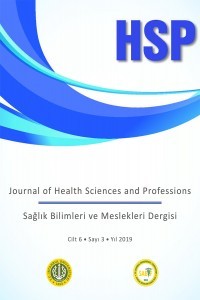Üniversite Öğrencilerinin Fonksiyonel Gıdalar Konusundaki Farkındalıklarının İncelenmesi
Bu araştırmanın amacı beslenme ve diyetetik eğitimi alan öğrencilerin fonksiyonel gıda konusundaki farkındalığının ortaya konmasıdır. Gereç ve Yöntem: Araştırmada seçilen örneklem grubunu kolayda örnekleme yöntemi kullanılarak seçilen Özel Üniversitenin Beslenme ve Diyetetik birinci ve dördüncü sınıf lisans öğrencileri oluşturmaktadır. Araştırma kapsamında toplam 80 öğrenciye veri toplama formu uygulandı. Bulgular: Dördüncü sınıf öğrencileri birinci sınıf öğrencileri ile karşılaştırıldığında eğitim seviyesi, yaş, aylık gelir, kendi sağlığı üzerinde kontrol sahibi olma, fonksiyonel gıdaları ilk nereden duyduğu değişkenlerine ilişkin anlamlı bir fark vardır(p˂0.05). Fonksiyonel gıdalara yönelik farkındalığı ve kullanım sıklığı ortalamalarına ilişkin aylık gelir grupları arasında anlamlı bir fark olduğu, bu farkın 5001TL ve üzerinde aylık gelire sahip olan gruptan kaynaklandığı görüldü. Ayrıca fonksiyonel gıdaların farkındalığı ve kullanım sıklığına ilişkin verilen cevapların genel ortalamalarına bakıldığında birinci sırada 3,74 ortalama ile “Tam tahıllı gevrekler, müsli”, ikinci sırada 3,66 ortalama ile “sarımsak” ve üçüncü sırada ise 3,65 ortalama ile “zencefil” olduğu belirlendi. Bu sonuç katılımcılar arasında en çok tanınan ve kullanılan ürünlerin bunlar olduğunu göstermektedir. Sonuç: Beslenme ve diyetetik eğitimi alan öğrencilerin aldıkları eğitimin, fonksiyonel gıdalar hakkındaki eğilimlerine katkı sağladığı görüldü. Fonksiyonel gıdaların sadece çalışma alanları beslenme ile ilgili olan öğrenciler arasında değil, diğer öğrenciler arasında da farkındalık sağlanmasına teşvik edilmelidir.
Research of Awareness of University Students on Functional Foods
Objective: The aim of this research is to reveal the awareness of the students who receive education on nutrition dietetics on functional foods. Materials and Methods: The sample group selected in the research consists of first and fourth grade undergraduate students of Nutrition and Dietetics of a Private University selected by using Convenience Sampling Method. Within the scope of the research, a data collection form was applied to 80 students in total. Results: There is a significant difference between fourth grade students and first grade students regarding the variables of the level of education, age, monthly income, control over their own health, and where they first heard about functional foods (p˂0.05). It was seen that there is a significant difference between the monthly income groups regarding the awareness and frequency of use of functional foods and that this difference arises from the group having a monthly income of 5001TL and more. Furthermore, when the general means of the responses to the awareness of the functional foods and the frequency of use are taken into consideration, it was determined that “Whole grain cereals, musli” was on the first rank with an average of 3.74, “garlic” was on the second rank with an average of 3.66 and “ginger” was on the third rank with an average of 3.65. This result indicates that these are the most recognized and used products among the participants Conclusion: It was seen that the education of the students who received nutrition and dietetics education contributed to their tendencies about functional foods. Fonctional foods should not only be encouraged among students whose study fields are related to nutrition, but also among other students in order to raise awareness.
___
- 1. Fewer L, Scholderer J, Lambert N. Consumer acceptance of functional foods: Issues for the future. British Food Journal.2003;105(10):714-31.2. Heasman M, Mellentin J.(2001). The functional foods revolution. Healthy People, Healthy Profits?, Earthscan Publications Ltd, London and Sterling, London.2001; pp:223. Abdel-Salam AM. Functional doos: Hopefulness to good health. American Journal of Food Technology. 2010;5(2):86-99
- 2. Heasman M, Mellentin J.(2001). The functional foods revolution. Healthy People, Healthy Profits?, Earthscan Publications Ltd, London and Sterling, London.2001; pp:22
- 3. Abdel-Salam AM. Functional doos: Hopefulness to good health. American Journal of Food Technology. 2010;5(2):86-99
